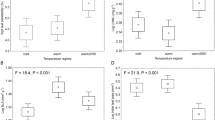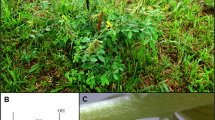Abstract
Although defence against herbivores is often argued to be the main action of plant secondary metabolites (PSMs)1, very few examples have demonstrated that intraspecific variation in PSM concentrations influences foraging by wild vertebrate herbivores2,3. Experiments with captive animals often indicate that PSM concentrations influence how much herbivores eat from individual plants3,4,5,6,7, but these experiments do not replicate the subtle trade-offs in diet selection faced by wild animals, which must avoid predators and extremes of weather, interact with conspecifics, and achieve a balanced, nutritious diet, while avoiding intoxication by PSMs. We characterized the foliar chemistry of every tree from two Eucalyptus species available to a population of koalas (Phascolarctos cinereus) and considered rates of tree visitation over a ten-year period. We show that visitation rate was most strongly influenced by tree size, but that koalas also visited trees less frequently if the foliage contained either high concentrations of deterrent PSMs known as formylated phloroglucinol compounds, or low concentrations of nitrogen. Consequently, plant chemistry restricts the use of trees by this herbivore, and thus limits the food available to koalas and potentially influences koala populations.
This is a preview of subscription content, access via your institution
Access options
Subscribe to this journal
Receive 51 print issues and online access
$199.00 per year
only $3.90 per issue
Buy this article
- Purchase on Springer Link
- Instant access to full article PDF
Prices may be subject to local taxes which are calculated during checkout



Similar content being viewed by others
References
Fraenkel, G. S. The raison d'être of secondary plant substances. Science 129, 1466–1470 (1959)
Vourc'h, G., Martin, J. L., Duncan, P., Escarre, J. & Clausen, T. P. Defensive adaptations of Thuja plicata to ungulate browsing: a comparative study between mainland and island populations. Oecologia 126, 84–93 (2001)
Farentinos, R. C., Capretta, P. J., Kepner, R. E. & Littlefield, V. M. Selective herbivory in tassel-eared squirrels: role of monoterpenes in ponderosa pines chosen as feeding trees. Science 213, 1273–1275 (1981)
Lawler, I. R., Foley, W. J. & Eschler, B. M. Foliar concentration of a single toxin creates habitat patchiness for a marsupial folivore. Ecology 81, 1327–1338 (2000)
Provenza, F. D. Postingestive feedback as an elementary determinant of food preference and intake in ruminants. J. Range Manage. 48, 2–17 (1995)
Duncan, A. J., Hartley, S. E. & Iason, G. R. The effect of monoterpene concentrations in Sitka spruce (Picea sitchensis) on the browsing behavior of red deer (Cervus elaphus). Can. J. Zool. 72, 1715–1720 (1994)
Bryant, J. P., Wieland, G. D., Reichardt, P. B., Lewis, V. E. & McCarthy, M. C. Pinosylvin methyl ether deters snowshoe hare feeding on green alder. Science 222, 1023–1025 (1983)
Moore, B. D., Foley, W. J., Wallis, I. R., Cowling, A. & Handasyde, K. A. Eucalyptus foliar chemistry explains koala feeding preferences. Biol. Lett. 1, 64–67 (2005)
Provenza, F. D., Villalba, J. J., Dziba, L. E., Atwood, S. B. & Banner, R. E. Linking herbivore experience, varied diets, and plant biochemical diversity. Small Rum. Res. 49, 257–274 (2003)
Freeland, W. J. & Janzen, D. H. Strategies in herbivory by mammals: the role of plant secondary compounds. Am. Nat. 108, 269–289 (1974)
Schmitz, O. J., Hik, D. S. & Sinclair, A. R. E. Plant chemical defense and twig selection by snowshoe hare: an optimal foraging perspective. Oikos 65, 295–300 (1992)
Villalba, J. J., Provenza, F. D. & Bryant, J. P. Consequences of the interaction between nutrients and plant secondary metabolites on herbivore selectivity: benefits or detriments for plants? Oikos 97, 282–292 (2002)
Westoby, M. What are the biological bases of varied diets? Am. Nat. 112, 627–631 (1978)
Moore, B. D., Wallis, I. R., Marsh, K. J. & Foley, W. J. in Conservation of Australia's Forest Fauna (ed. Lunney, D.) 549–575 (Royal Zoological Society of New South Wales, Mosman, NSW, 2004)
Eschler, B. M., Pass, D. M., Willis, R. & Foley, W. J. Distribution of foliar formylated phloroglucinol derivatives amongst Eucalyptus species. Biochem. Syst. Ecol. 28, 813–824 (2000)
Danell, K., Edenius, L. & Lundberg, P. Herbivory and tree stand composition: moose patch use in winter. Ecology 72, 1350–1357 (1991)
Moore, B. D. et al. Anti-herbivore chemistry of Eucalyptus—cues and deterrents for marsupial folivores. J. Chem. Ecol. 30, 1743–1769 (2004)
Hume, I. D. Marsupial Nutrition Ch. 5 (Cambridge Univ. Press, Cambridge/New York, 1999)
Ullrey, D. E., Robinson, P. T. & Whetter, P. A. Composition of preferred and rejected Eucalyptus browse offered to captive koalas, Phascolarctos cinereus (Marsupialia). Aust. J. Zool. 29, 839–846 (1981)
Degabriele, R. Nitrogen and the koala (Phascolarctos cinereus): some indirect evidence. Aust. J. Ecol. 8, 75–76 (1983)
Degabriele, R. A relative shortage of nitrogenous food in the ecology of the koala (Phascolarctos cinereus). Aust. J. Ecol. 6, 139–141 (1981)
White, T. C. R. The Inadequate Environment: Nitrogen and the Abundance of Animals Ch. 6.5.1 (Springer, Berlin, 1993)
Hindell, M. A., Handasyde, K. A. & Lee, A. K. Tree species selection by free-ranging koala populations in Victoria. Aust. Wildlife Res. 12, 137–144 (1985)
Scrivener, N. J. et al. Which trees do wild common brushtail possums (Trichosurus vulpecula) prefer? Problems and solutions in scaling laboratory findings to diet selection in the field. Evol. Ecol. Res. 6, 77–87 (2004)
Martin, R. W. Overbrowsing, and decline of a population of the koala, Phascolarctos cinereus, in Victoria. I. Food preference and food tree defoliation. Aust. Wildlife Res. 12, 355–365 (1985)
O'Reilly-Wapstra, J. M., McArthur, C. & Potts, B. M. Genetic variation in resistance of Eucalyptus globulus to marsupial browsers. Oecologia 130, 289–296 (2002)
Moore, B. D., Wallis, I. R., Wood, J. & Foley, W. J. Foliar nutrition, site quality and temperature affect foliar chemistry of tallowwood (Eucalyptus microcorys). Ecol. Monogr. 74, 553–568 (2004)
Martin, R. W. & Handasyde, K. A. The koala: natural history, conservation and management. Ch. 4 (Univ. New South Wales Press, Sydney, 1999)
McIlwee, A. M., Lawler, I. R., Cork, S. J. & Foley, W. J. Coping with chemical complexity in mammal-plant interactions: near-infrared spectroscopy as a predictor of Eucalyptus foliar nutrients and of the feeding rates of folivorous marsupials. Oecologia 128, 539–548 (2001)
Acknowledgements
We are grateful to A. Reed and ‘Friends of the Koalas Inc.’ for the use of their koala data; I. Lawler , K. Handasyde, I. Wallis, R. Bednarik, M. Ebbers and K. Marsh for assistance in the field and laboratory; Phillip Island Nature Park for allowing access to the Koala Conservation Centre and for providing accommodation to B.D.M.; the Australian Research Council for funding to W.J.F.; and C. Johnson, M. Jennions, J. DeGabriel and M. Symonds for comments on the manuscript.
Author information
Authors and Affiliations
Corresponding author
Ethics declarations
Competing interests
Reprints and permissions information is available at npg.nature.com/reprintsandpermissions. The authors declare no competing financial interests.
Supplementary information
Supplementary Table S1
Details of calibration sample sets and calibration equations used to predict chemical attributes of foliage samples using near infrared spectroscopy. (DOC 27 kb)
Supplementary Notes
A description of the statistical relationships between tree size and foliar chemistry in E. globulus and E. viminalis. (DOC 24 kb)
Rights and permissions
About this article
Cite this article
Moore, B., Foley, W. Tree use by koalas in a chemically complex landscape. Nature 435, 488–490 (2005). https://doi.org/10.1038/nature03551
Received:
Accepted:
Issue Date:
DOI: https://doi.org/10.1038/nature03551
This article is cited by
-
Roads and water availability influence the occurrence of koalas (Phascolarctos cinereus) in secondary habitat: a multiscale approach
Biodiversity and Conservation (2023)
-
Protected area coverage has a positive effect on koala occurrence in Eastern Australia
Biodiversity and Conservation (2023)
-
How microbiomes can help inform conservation: landscape characterisation of gut microbiota helps shed light on additional population structure in a specialist folivore
Animal Microbiome (2022)
-
Deconstructing Protein in the Diet and Biomass of Colobine Primates
International Journal of Primatology (2021)
-
Effects of Eucalypt Plant Monoterpenes on Koala (Phascolarctos Cinereus) Cytokine Expression In Vitro
Scientific Reports (2019)
Comments
By submitting a comment you agree to abide by our Terms and Community Guidelines. If you find something abusive or that does not comply with our terms or guidelines please flag it as inappropriate.



